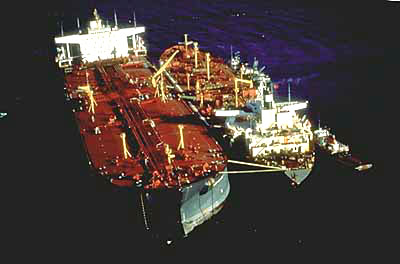
http://response.restoration.noaa.gov/photos/exxon/03.html |
THE PETROLEUM ZONE
WHAT HAPPENS WHEN WE RUN
OUT?

http://response.restoration.noaa.gov/photos/exxon/03.html |
Likely, previously peaceful nations will become more malevolent with dwindling and more expensive sources of fuel energy. A lack of petroleum could easily destabilize world-wide relations and lead to a major war. Also, large oil reliant suppliers of such goods as plastics, heating oil, kerosene, and construction material would be at a loss for the necessary raw materials. Petroleum reliant power plants would be out of production, and the transportation industry would have no gasoline for its vehicles.
Our society will not necessarily fall into the stone age or into world war, however, as there are a large number of alternative, sources of energy. The supply of coal will last hundreds of years to maintain our electricity needs.
Transportation, which accounts for 35% of energy used, will however need to be steered toward non-petroleum based materials as sources of energy. Non fossil fuels, or ones that can be made to last a lot longer, are called renewable sources of energy.
RENEWABLE SOURCES OF ENERGY:
SOLAR POWER:
To use solar power means to harness the energy in the sun's rays via any sort of solar energy collector. This energy can be used to run a heat engine or can be directly converted to electricity to provide for power needs. Several prototypes of vehicles have been designed which use solar power as a means of transportation. However, solar energy is not evenly disbursed throughout the earth (cities close to the arctic and antarctic circles will have much too little daylight). Solar power plants can also use solar collectors as a means of collecting energy. Solar paneling collects the sun's energy to run heat engines, heat homes, and generate electricity.
GEOTHERMAL:
Geothermal power is entirely impractical for use in transportation, as it requires that the energy be extracted from a stationary spot in the ground, using the temperature difference deep in the earth to run an electricity producing steam engine. It can be used in electricity generation and as a source of generating heat without the need for additional electricity . Geothermal power is limited slightly though, because a power plant will eventually cool the rock below it and the amount of power produced will eventually run out, but not for many hundreds of years.
NUCLEAR FISSION / FUSION:
Fission power has been used since the 1940's as a means of producing electricity. The world's current supply of fissionable Uranium 235 is indeed limited to a supply of around 20 years. However, it can be made to last many thousands of years by using new fast breeder reactors.
Fission power is essentially the opposite of fusion. Fission is the splitting of a large atom to form new atoms, releasing neutrons which in turn split other atoms to continue the reaction. Fission is when two smaller isotopes of atoms are forcibly combined. The new atom's weight is smaller than that of the atoms which fused, and that missing mass was effectively turned into (potentially useful) energy. As of yet a working fusion power plant has not been built, but may become possible several decades in the future with continued research.
Theoretically, a fusion reaction on a small scale could be used to power
automobiles and provide transportation.
TIDAL / O.T.E.C.:
It is theorized that power can be obtained by using the natural changes in water level across the globe. Due to the effects of the moon and sun's gravity, the earth's ocean level rises and falls on a daily basis. Power may be obtained by constructing a system of coastal dams which capture water at high tide and release it again at low tide.
Also theoretically possible is the use of the Ocean's natural temperature gradient as a source of power. The gradient is the difference in temperature between the surface of the water and the bottom of the ocean. The power plant would have to use the coldness of the depths against the relative warmth of the surface to run an electricity producing heat engine. Such a power plant would be known as an O.T.E.C. (or Ocean Thermal Energy Conversion) power plant. This can't be used directly for transportation, but may help power future electric cars with the electricity produced from these power plants.
CONSERVATION:
The consumption of another hundred billion barrels of petroleum would
still cause harm to the environment in the form of Carbon Dioxide emissions
into the environment. The best answer to solving supply problems
as well as the harm to the environment is to look toward energy conservation,
such as more efficient engines in cars, more aerodynamic vehicle designs,
carpooling, and other strategies for saving fuel. Already, cars with
hybrid engines (electric power as well as gasoline) can get as much as
twice the gas mileage as existing cars with exactly the same performance.
by Mike Martinez, 2002
|
|
|
|
|